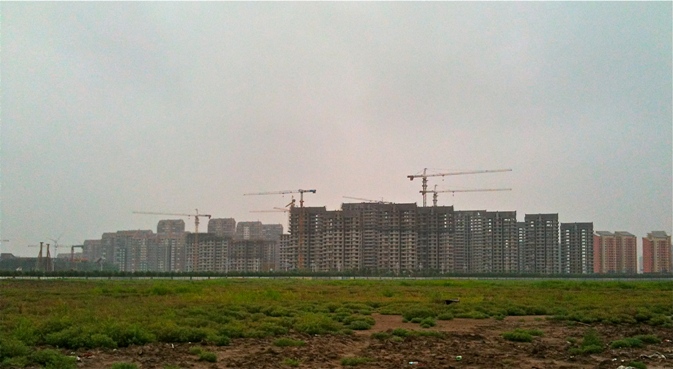China Tries Greening from the Ground Up

From green building rules to carpool privileges for electric cars, California has moved in recent years to plan for a more sustainable future. It’s a trend here, but nowhere is the urgency greater than in China, where hundreds of millions of people are moving to cities in pursuit of a better life.
China’s urbanization has come at a tremendous cost: pollution, traffic congestion, surging energy use and more carbon dioxide emissions. Now, China is partnering with experts in the Bay Area on a huge experiment—building new cities to be environmentally sustainable.
China’s Eco-city Showcase
Zhang Xi is a pretty, willowy woman. And she’s an urban pioneer. She and her family are among the first tenants of Tianjin Eco-city, a showcase for China’s push to build sustainable cities from scratch. Zhang moved here from Beijing, about an hour to the north by bullet train. She was enticed by a new job and a shorter commute to work. Much shorter.
“It’s just three minutes by elevator, so it's really convenient,” Zhang told me through a translator. She "used to take the subway for half an hour, then change to a bus. That would take one hour."
Now Zhang, a customer service rep, lives and works in the same high-rise. Her quick commute—albeit an extreme case--is one of the core principles of an eco-city: cut car use. Walkable streets are key too-- short city blocks, intersections that are easy to cross.
The area bears no resemblance to what was here just a few years ago. "When this project was first conceived in 2007, this was just a barren site,” said Ho Tong Yen, CEO of the company developing the Tianjin Eco-city and the visionary for this $8 billion experiment. “It comprised saline and alkaline land, polluted water bodies. There was nothing inherently ‘eco’ about this site at all."
But with the backing of the governments of China and Singapore, developers cleaned up the site. Clusters of new high-rises now dot the flat terrain here, with more under construction. There’s a mix of public housing and private, upscale apartments, all built to be energy-efficient.
Five thousand families have already bought homes here. By 2020, if plans pan out, Tianjin Eco-city will swell to 350,000--nearly the size of Oakland. This development is one of dozens of pilot projects around China spearheaded by the central government to serve as models for future cities.
Rural Migration Fuels Urban Problems
The need is urgent. In the past year, the number of people living in cities here surpassed the rural population for the first time. While this migration has fueled China’s remarkable economic boom, major cities--like Beijing—are beset with pollution and traffic congestion, which wastes energy. What’s more, commutes between home and work are often long, which means more pollution and greenhouse gases. That’s because single-use zoning often separates commercial districts from residential areas.
The problems are sure to worsen without better planning. By 2030, as many as 300 million more Chinese are expected to move from the countryside to urban areas. That’s enough people to create 79 cities the size of Los Angeles.
Tapping California for Advice
So to prepare for that, several Chinese cities have partnered with a Bay Area firm for advice. One tip they got from Peter Calthorpe, president of Calthorpe Associates, an urban design group based in Berkeley: good urban design comes first, then add clean technology.
When the mayor of a major Chinese city asked Calthorpe to redesign an area for a million-and-a-half people, the first things to go were the really long city blocks that are typical here. "We got in and modified the street system so there were more human-scale blocks and smaller streets everywhere,” says Calthorpe. “We mixed the land use so you didn’t have to walk very far to school, parks or stores. And we concentrated development around the transit stations.”
Calthorpe has applied some of the same principles to projects in the Bay Area, including new developments at Alameda Point and Bay Meadows in San Mateo.
How ‘Eco’ is Tianjin Eco-City?
But Tianjin Eco-city executive Ho Tong Yen says, "There is no one definition of what it means to be an eco-city. So what we have done is put together a set of key performance indicators, which we think are stretch targets; they are ambitious but achievable.” Those include 20% of the town’s electricity from renewable sources (low by some standards today), and half its water from harvesting rain and other “non-traditional” sources.
At a popular new Korean restaurant in Tianjin Eco-city, it’s lunchtime and the place is packed. The restaurant is just a couple minutes walk from apartments and offices. Eventually there will be a light rail system and a large park extending through the middle of the city. But clearly there are still some design flaws to work out.
"So just to get around the corner and up the street you have to walk a really long way,” says Cecilia Springer. She’s a Fulbright scholar who’s studied Tianjin Eco-city. “You can't really cut through the middle of the blocks." She also points out that to get to the closest major city center--in Tianjin--you have to get in a car and drive at least a half an hour. "So one could call it a Chinese suburb,” Springer says, “and that raises a lot of questions of how green can a suburb can really be."
Another valid question is how many “green suburbs” it will take to arrest the environmental consequences of China’s economic growth. It’s a race against time as millions more migrate to the nation’s cities and China’s growing middle class pursues a more comfortable, “Western” lifestyle.

